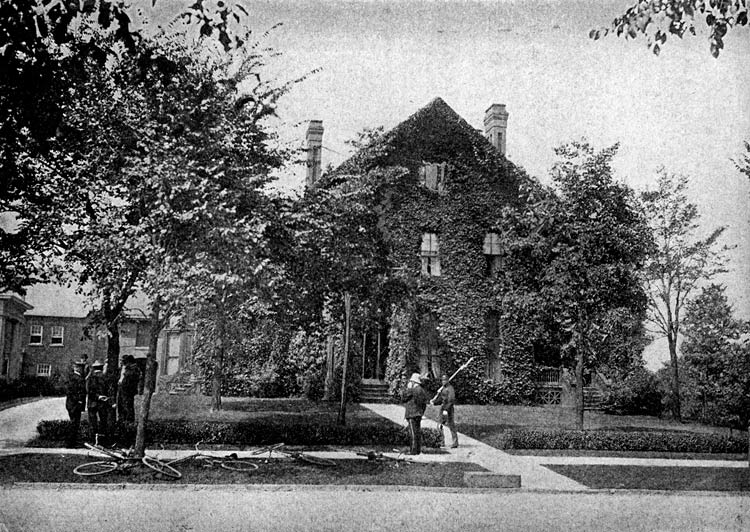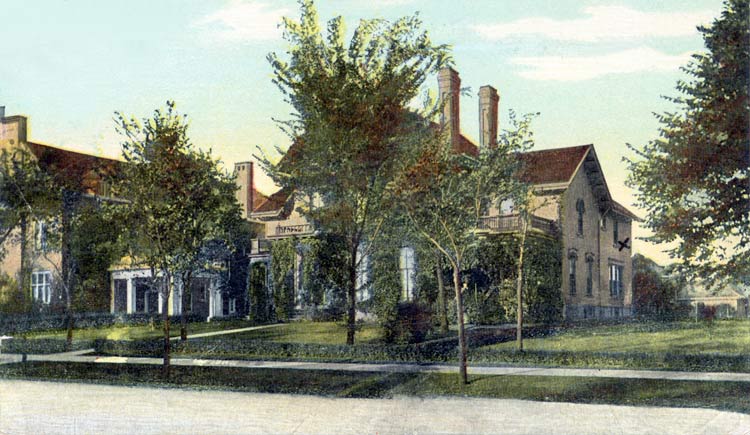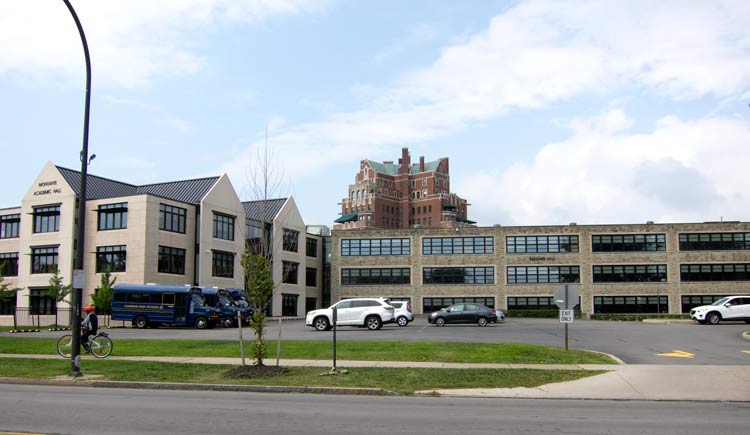
xxxxx.
Image source: private collection
The house known in memory today as the Milburn House was built in 1861 for George C. Vaughan. Over the next twenty-seven years, it was owned by Edward Darley, Erastus Scoville, Esther Osborn, George Chadeayne, and Edward Eames. In 1888, John G. Milburn bought it. Milburn, born in England in 1851, came to the United States at age eighteen, settling in Batavia and learning law. He moved to Buffalo, formed a law partnership with E.C. Sprague and Henry W. Sprague (Sprague, Milburn and Sprague) in 1879. He moved to Denver, Colorado for a short time and returned to form a partnership with Sherman S. Rogers and Franklin D. Locke. |
Winter view of the Milburn House, Buffalo policeman on guard against souvenir hunters. The barn at left was part of the Milburn property. Image source: private collection.
John G. Milburn married Mary Patty Stocking of Batavia in 1876. She had been a teacher in her aunt's exclusive girls' seminary prior to marriage. In their Buffalo home at 1168 Delaware Avenue, the Milburns entertained prominent Americans as well as international celebrities such as Matthew Arnold, who exclaimed after visiting, "Here are two people who know the art of living!" It was not surprising that the Board of Directors of the newly created Pan American Exposition Company chose Milburn to be its president in 1899. In 1900, the Milburns remodeled their home in expectation of entertaining national and international figures duirng the Exposition. Both side porches were converted into wings and a small porch over the front entrance was removed. When plans were finalized for President McKinley and his wife to visit the Exposition, the Milburns were prepared to host them at their home. They provided a suite of rooms on the second floor along the north side (right hand above) of the house to their special guests. In the front room, facing the street, was a small sitting room decorated in purple and gray velours with draped walls. The bedroom was 18 x 20 feet large, with north-facing windows and a large marble fireplace. It featured a brass and gold bedstead with a worked counterpane, a chiffonier, dresser, and divan. The walls were tapestried. A third room in the suite was a bedroom also. |

xxx
The McKinleys arrived in Buffalo on September 5, 1901, named "President's Day at the Exposition, " and stayed the night with the Milburns. The next day, after a morning in Niagara Falls, President McKinley went to the Temple of Music on the Exposition grounds for a reception while Mrs. McKinley returned to the Milburn home to rest. The President was shot by anarchist Leon Czolgosz shortly after 4 p.m. and, after an operation in the Exposition's hospital, was brought to the Milburn house. The Milburns became host to many more people suddenly as McKinley relatives arrived, in addition to staff and cabinet officers whose job was to maintain the workings of the government from the home. Household staff were quickly exhausted by providing housekeeping and meals at all hours, and staff from neighboring homes were lent to help provide service. On September 14, at 2:15 a.m., President William McKinley died. The house quickly became a funeral home of sorts, as friends arrived continuously to pay their respects. By the end of September 16, the Milburn house was restored to its owners, after the President's casket was carried out, and thirty carriages removed the relatives and government officials. After they left, workers removed big oxygen tanks that had been brought to ease the President's breathing and large electric fans that were kept running in the President's room during the very hot weather that month. The Buffalo Evening News said, "Then the place was left to the curious ones and to the police." For a period after, Buffalo police patrolled the sidewalk in front of the house in an attempt to keep away souvenir hunters who chipped stone and brick from the house, and cut branches from the lilac bushes and other vegetation.. |


xxx
The Milburns remained in Buffalo until 1904, when John G. Milburn became partner in the New York City firm of Carter and Ledyard. They moved to that city and remained there until his death in 1930. Phillip M. Shannon purchased the house at 1168 Delaware from the Milburns for his residence. He rearranged the interior somewhat. On January 10, 1907, fire severely damaged the house, ruining the room in which President McKinley died. Daughter Hazel Shannon was alone in the house with a guest when the fire began. The fire, believed to have started in the telephone room, was put out by city firefighters with water and chemicals. The combined effects of fire and firefighting left only the dining room relatively unspoiled. The house was restored and in November 1919, Mrs. Shannon converted the house into apartments, constructing an addition and converting the McKinley bedroom into a living room of one apartment. The apartments were let to a discriminating class of renters. In 1928, Conrad Wettlaufer the property and further remodeled it, making eight apartments in all. The Jesuit community of Canisius High School, located next door to the Milburn property, purchased it in 1948 and moved into the apartments, which from that time forward became a cloistered building. Then in 1957, Canisius High School announced plans to demolish the 96 year old structure, no longer having a use for it and desirous of additional space on its campus. The demolition occured as soon as the contracts were let. To mark the site of the house, the Buffalo Historical Society (now known as Buffalo & Erie County Historical Society) placed a marker along the curb.
|
xxxxxxxx
